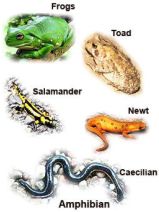Amphibia
Super-class - Tetrapoda (bear limbs)
(i) Class - Amphibia
- Class Amphibia refers to a group of vertebrates that includes frogs, toads, salamanders, and caecilians.
- They are characterised by their ability to live both in water and on land, undergoing metamorphosis from an aquatic larval stage to a terrestrial adult stage.
General Characteristics:
- Amphibians have a dual life, spending their larval stage in water and their adult stage on land.
- Tail may be present in some.
- They have moist, glandular skin that allows for cutaneous respiration.
- The amphibian skin is moist (without scales).
- The eyes have eyelids.
- A tympanum represents the ear.
- They possess a three-chambered heart, consisting of two atria and one ventricle.
- Limbs, when present, are typically pentadactyl (having five digits).
Respiration:
- Amphibians respire through both lungs and their skin.
- Cutaneous respiration, or gas exchange through the skin, is especially important for larval stages and for some lungless species.
- Adult amphibians have lungs, which supplement their respiratory needs when on land.
Feeding Habits:
- Amphibians exhibit diverse feeding habits, including herbivory, carnivory, and omnivory.
- Larval amphibians are primarily herbivorous, feeding on plants, algae, and small invertebrates.
- Adult amphibians may feed on insects, small vertebrates, or even consume plant matter.
Circulatory System:
- Amphibians have a double circulation system.
- Their heart pumps oxygenated blood from the lungs to the body and deoxygenated blood from the body to the lungs.
- Oxygenated and deoxygenated blood partially mix in the single ventricle, reducing the efficiency of oxygen delivery.
Excretion:
- Amphibians excrete nitrogenous wastes primarily in the form of urea.
- They possess paired kidneys, which help in maintaining water and ion balance.
- Alimentary canal, urinary and reproductive tracts open into a common chamber called cloaca (opens exterior).
Reproduction:
- Amphibians exhibit various modes of reproduction, including external fertilisation and internal fertilisation.
- Many species lay eggs in water, where external fertilisation takes place.
- Fertilised eggs develop into larvae, which undergo metamorphosis to transform into the adult form.
Economic Importance:
- Some amphibians are used as bioindicators to monitor the health of ecosystems.
- Certain species of amphibians, like frogs and toads, are kept as pets or used for research purposes.
- Amphibians also play a crucial ecological role by controlling populations of insects and other invertebrates.
Examples:
- Frog (Rana tigrina)
- Toad (Bufo melanostictus)
- Salamander (Tylototriton verrucosus)
- Caecilian (Ichthyophis)
